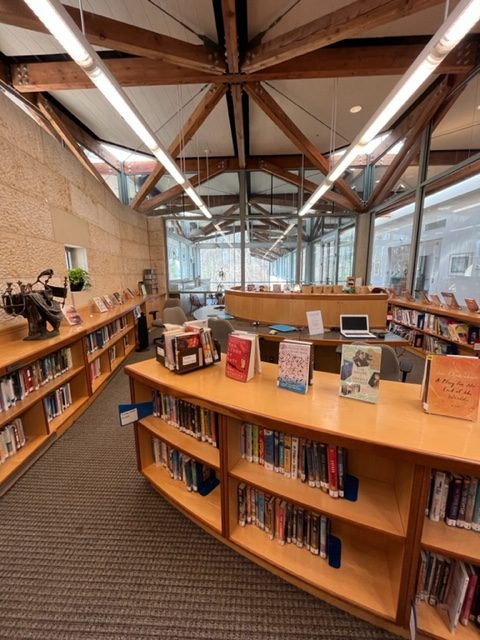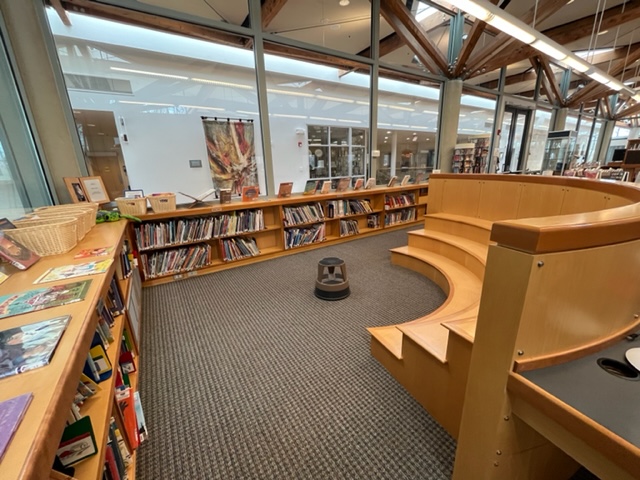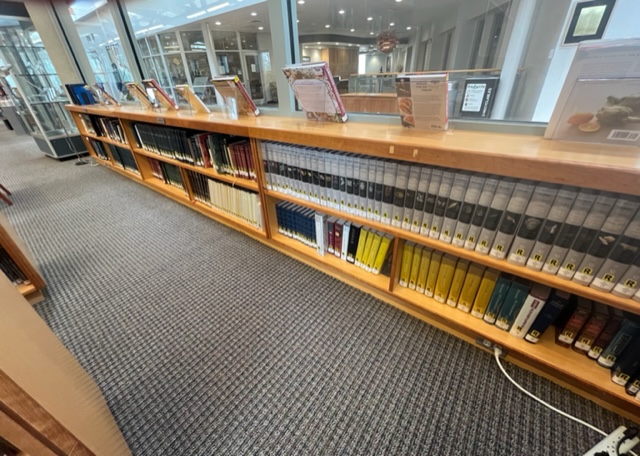For my special collections library visit, I chose Temple Rodef Shalom Library, https://trs-hl.mimas.opalsinfo.net/bin/home located in Falls Church, Virginia, which is the largest Jewish congregation in Virginia. Before my visit, I called to schedule an appointment to observe the library. The librarian was thrilled to have an MLIS student visit. No one has ever completed an assignment on this library and decided to give me a tour, discuss the collection, and chat with me after I finished my observation.
Space and Physical Access
The library is in a beautiful synagogue in a quiet neighborhood. It is on a bus line and has multiple accessible parking spaces. I was surprised to see that the building looked more like an event space than a traditional temple. As I approached the parking lot, I noticed a large hearse parked at the entrance, which is unusual for a school, public, or academic library, but it is a regular occurrence at this location. At first, I was worried I got the time wrong. Although I walked towards the synagogue entrance along with the mourners, it was awkward, and I wasn’t sure what I was supposed to do. I felt like I was intruding on a private moment. However, one of the employees was holding the door open for the mourners, and as I approached, she knew who I was and that Susan, the librarian, was waiting for me inside. I signed in with the security guard and walked to the library, which is on the main level right next to the entrance of the building.
The library has gorgeous vaulted ceilings with wood beams and an entire wall of windows looking into the building. Handpicked displays faced outward to the synagogue, luring people in as they passed by. It reminded me of department store windows. An extensive service desk is at the center of the library. Adult Fiction, YA Fiction, and a small graphic novel section were to the right. The most sizable collection on this end of the library was Children’s Lit from Pre-K to Middle grades. In addition, there was a small storytime pit where the librarian reads to both the preschoolers and lower grades at the religious school located inside the building. Behind the storytime pit was a long counter with three desk chairs and three Chromebooks for the patrons. Through the Chromebooks, patrons can access the catalog and internet.
On the left side of the service desk are nonfiction, biographies, Jewish magazines, and an extensive reference collection, many items being religious texts. Nestled in a cozy corner, there are two lounge chairs for patrons to read. Although the library is small, it felt open and bright due to the high vaulted ceilings, creating a warm and welcoming atmosphere.

Services and Intellectual Access
I was surprised to see the library organized by Dewey, especially after learning about his anti-Semitism in Rubin and Rubin (2020) (p. 276). The librarian said Jewish libraries have two classification systems, Weine and Elazar. However, she explained that for her collection, particularly the nonfiction section, she prefers the updated classification system of Dewey. I did not see any special services on my visit. Still, the librarian shared that besides storytime, she offers one-on-one consultations with patrons for research purposes, religious questions, or book recommendations. She shared that one of the most asked questions is to help find the “right” Haggadah (prayer book recited at Sedar during Passover.) She has multiple copies of various Haggadah books. An example she gave is families who want a Haggadah that can accommodate a four-year-old, all the way up to a ninety-year-old. On many occasions, she assists patrons by helping them write their own Haggadah. Learning about her collaborations with patrons made me think about special collection librarians “research and find the answer for patrons, rather than a patron expecting to locate the answer with the librarian’s assistance, and they tend to emphasize the provision of information for practical purposes rather than instruction on how to find information” (White, 1984, as cited in Rubin & Rubin, 2020, p. 160).
In addition to storytime, she also teaches Sunday school in the library. During the high holidays, she will teach five classes a day to the religious school in the building. The signage could be improved. I was confused about what was what and where to locate materials. The librarian said it was something she was working on this year to improve.

Collections
This collection is specialized because every book is either written by a Jewish author, is a religious text, or has well-researched Judaica content, particularly concerning fiction. The fiction titles must be about Jewish stories and amplifying their voices. While the Adult and Children’s fiction section was quite large, I was disappointed by the lack of YA books, although almost all won the Syndey Taylor award. The YA fiction books only took up two shelves. I noticed the lack of YA Jewish authors and stories in my school collection. Almost all of Judaica YA fiction is about the Holocaust. I asked the librarian why there is such a significant disparity of Jewish YA books in comparison to BIPOC and LGBTQ+, and she responded that “many authors are not kneeling into the genre and also publishers do not buy them because they do not believe they will sell (S. Kussel, personal communication, March 22, 2022).
In addition to the collections I mentioned earlier, some CDs and DVDs circulate. However, the religious texts and other reference materials do not circulate. I found it particularly interesting that I noticed she had three different versions of the Talmud (religious texts of Jewish Law.) She explained that all three of them were written at other times. The first was written before the war in the 1930s, the second was written after the war in the 1970s, and the last set was written very recently. She said, “it is important to keep all three because depending on when each set was written, the content changes because of the war, and if you discard older texts, they will be lost and forgotten because they are out of print” (S. Kussel, personal communication, March 22, 2022).

People – Patrons & Staff
The library is open six days a week whenever the building is open and is staffed with one part-time librarian who has an MLIS. Although you have to be a member to attend the temple, the library serves the public. Anyone can check out materials for three weeks and may renew items similar to other libraries. This library does not use an integrated library management system but instead uses due date slips with library card pockets. When the librarian is not there, anyone can enter the library and check out the materials themselves. Rubin and Rubin (2020) state that “scarce resources create challenges. Shrinking budgets mean fewer personnel, and often a single person might perform multiple functions” (p. 161). The librarian shared that not only does she find research materials, she is also in charge of ordering cataloging using the Dewey Decimal Classification and Relative Index since she does not have library management software. She also processes new books, shelves, checks out and in materials, creates displays, and discards materials, although discarding any books containing God’s word gets tricky. She explained that in Jewish culture any texts that contain the word God must be buried on holy ground like a Jewish cemetery.
I visited this library on a midmorning on a Tuesday. Four people came into the library during my visit. An elderly couple who attended the funeral needed help to locate a specific cookbook, and two teachers from the religious school asked for particular materials for upcoming lessons.
All of the people I encountered were Jewish, but not all identified as white. I met two employees of the synagogue who identify as black women. Every person I encountered in the library and throughout the building was friendly and helpful. I felt welcome despite it being a religious organization.
Digital Access
The website could use some work. Although I appreciated the new book titles and award winners, I didn’t find it clean or user-friendly for those who may need technical assistance. The librarian shared that it is a conscious choice not to spend time developing the website because most of her patrons do not utilize it or even know it is there. In addition, many of her patrons are elderly and need assistance with technology. She stated that “99% of the time, patrons visit in person and ask for what they need” (S. Kussel, personal communication, March 22, 2022). There are featured genre collections if a patron wants to search the catalog along with resource lists. The staff, hours, and location are on the website in addition to the services provided.
Other
This visit was my favorite library visit. I encountered unique experiences like entering the building with mourners for a funeral scheduled across from the library. From the beginning, it was evident that I was in a holy building, surrounded by a large involved but welcoming community. I was surprised at how large the building was. Not only does it house a library, but it also has two sanctuaries where services are held, and ample event space for weddings, funerals, and Bar/Bat Mitzvah, one preschool open to the public and members, one religious school, meeting spaces, a large suite for the clergy, and seven acres of land with three playgrounds, and one meditation garden. I was surprised to learn that anyone can visit the library and check out materials. I am curious how this Judaica library compares to other Judaica libraries. I noticed there were no trashcans or book drops outside of the temple. I asked Susan why that was, and she responded that “temples do not have any item outside because there is a real threat with anti-Semantists placing bombs in receptacles” (S. Kussel, personal communication, March 22, 2022). Her statement chilled me to the bone and weighed heavy on my heart. I can see myself revisiting this library and reading in the meditation garden. It was a wonderful experience.
References
Rubin, R. E. and Rubin, R. G. (2020). Foundations of library and information science
(5th ed.). ALA Neal-Schuman.
What an amazing library to visit! I find it interesting that they have the three versions of the Talmud from different eras in history. It is extremely important to keep those available so patrons can experience the various times between the wars. I’m curious about how they weed books from the collection since you said that in Jewish culture any literature with the word of God must be buried on holy ground. Overall, the library seems very educational and helpful to the Jewish community while projecting a peaceful atmosphere. I can see why patrons would visit!
Hi Kat, the librarian I spoke with said that she only discards materials containing the word God if they are damaged beyond repair. In that case, she would take those books and bury them on holy ground. The example she gave was a Jewish cemetery. I’m not sure of the frequency, but since this is a specialized collection with a minimal budget, it didn’t sound like she discarded items regularly. However, it would be worth following up with her and asking if I could tag along whenever she does weed. I am also curious!
What an amazing visit for you! I was so enthralled to be along for the ride! Wow, so much information I had never considered about a library in a temple. Admittedly, I am very ignorant about the Jewish religion and I am happy to have learned some things today. That comment the librarian made about not providing places for hiding bombs in a trashcan or book return was absolutely chilling.
Hi Jessica, before my visit, I only knew the most basic amount of knowledge about Judaism. I was fascinated the entire time. Susan is a beautiful storyteller. I thoroughly enjoyed listening to her share her knowledge and watching her beam with pride over her culture and library. The most bizarre feeling was entering with many mourners with a hearse parked out front, but she said that is a regular occurrence. I am still disturbed by the bomb statement, mainly because I can’t comprehend that level of hate for anything. It was an incredible library, and I am looking forward to visiting again.
This is such an amazing visit! The building is beautiful! I am very impressed with their children’s section and seating. This is a wonderful resource for those searching out Jewish media and literature. I can understand the awkward feeling with visiting during a mourning, but I understand its location makes that common. The fact that they don’t have book drops or trash cans due to threats is a very troubling reality. This library is extremely interesting to me, and I do not identify as Jewish. It did lead me to think on all the books I have read throughout my life, and I can not think of a single Jewish character. Though I would hope I have come across Jewish authors, I can’t say that for sure.
I walked in, not knowing what to expect. I anticipated religious texts, but I was pleasantly surprised to see a large fiction section, and the children’s storytime pit was the cherry on top. While speaking with the librarian, I also could not remember reading about Jewish characters in literature that wasn’t about the holocaust. Unfortunately, there is a noticeable gap between the big five publishers. Hopefully, we will see that change in the near future. The building was beautiful, I wanted to include more pictures, but the max was three. Although I am not Jewish, I felt serene and at peace during my visit.
Wow! What an exciting library to visit! I was so happy that the librarian gave you a tour, and it seems to provide outstanding information. The temple is stunning and so organized. I was sad to hear about the limited amount of YA literature and the lack of support for that genre for Jewish authors. Thank you for beautifully transcribing your visit.
I was thrilled she was there to answer my questions, especially since I am not Jewish and would have been confused at times. Susan was full of information and helped me understand why her collection is unique and helpful to her patrons.